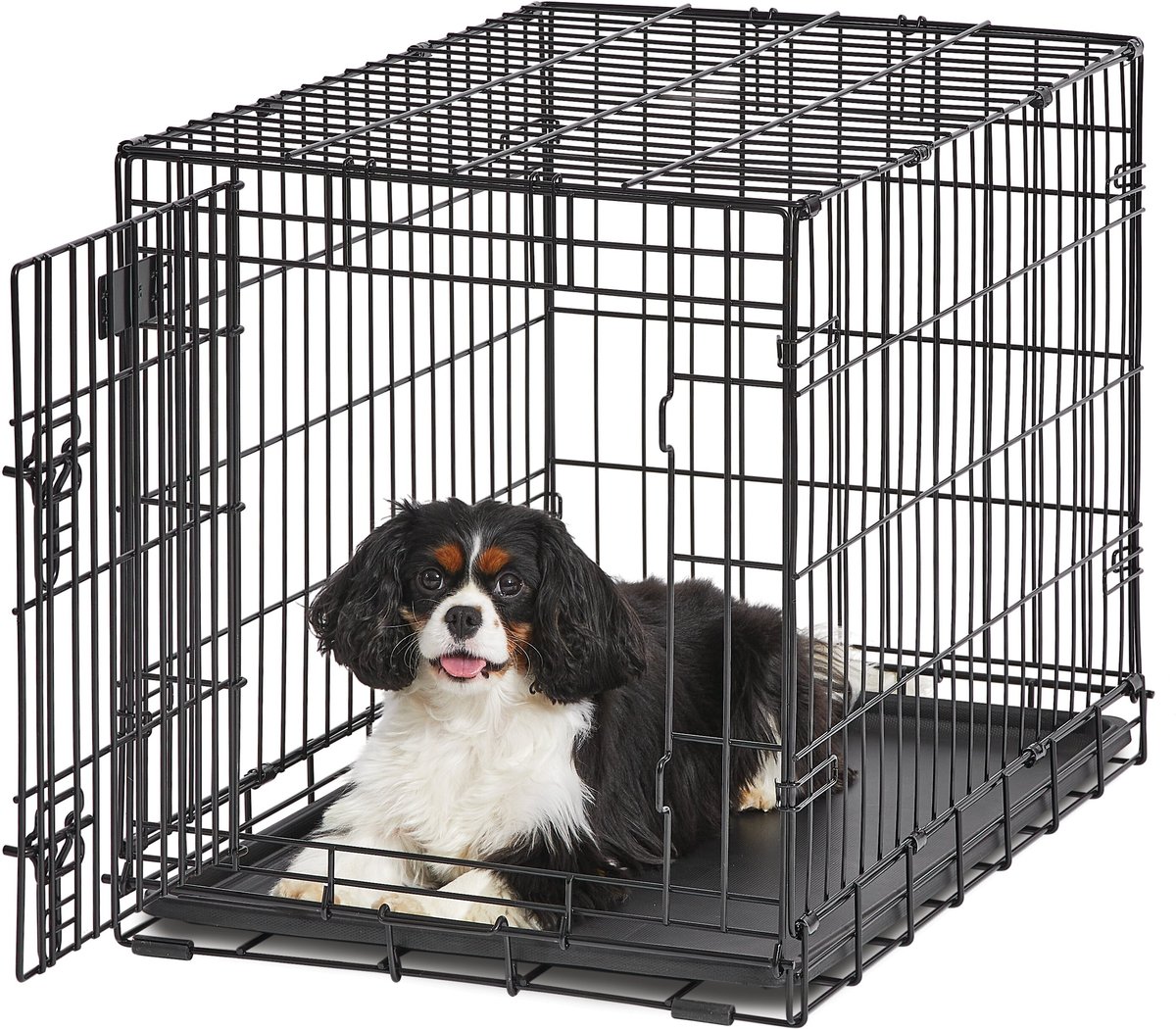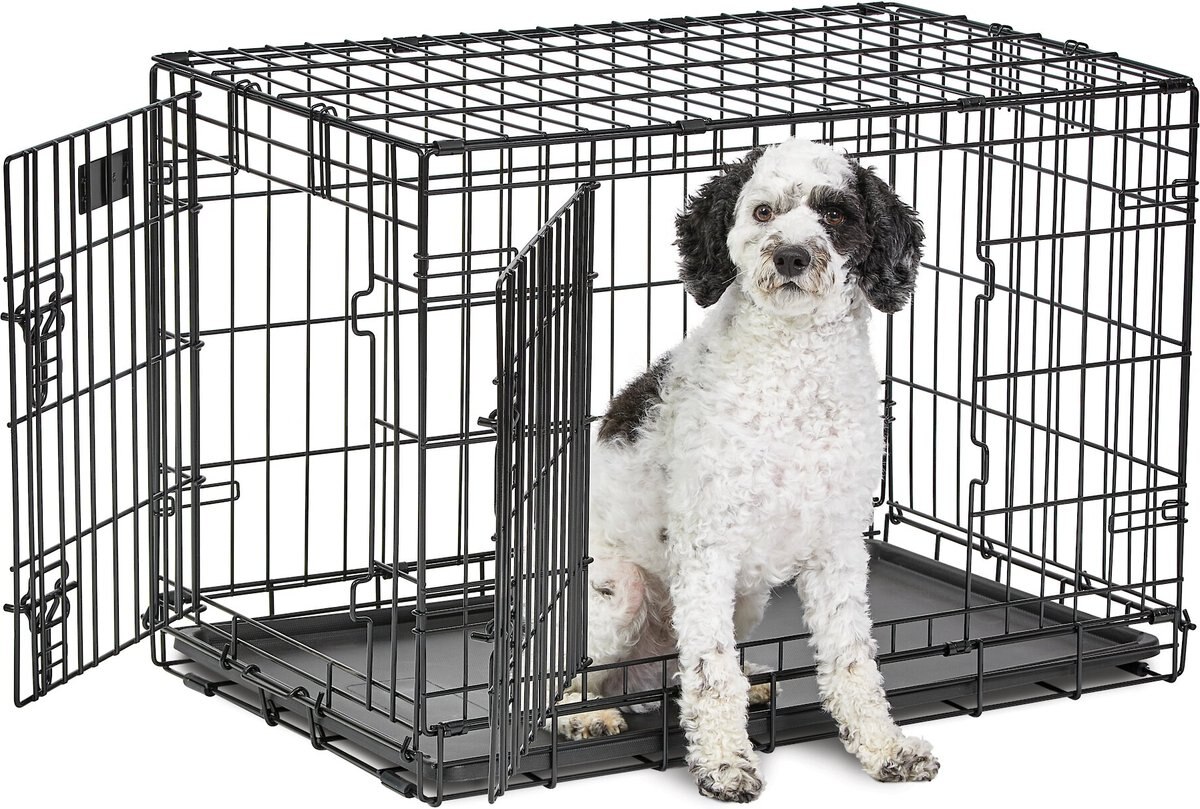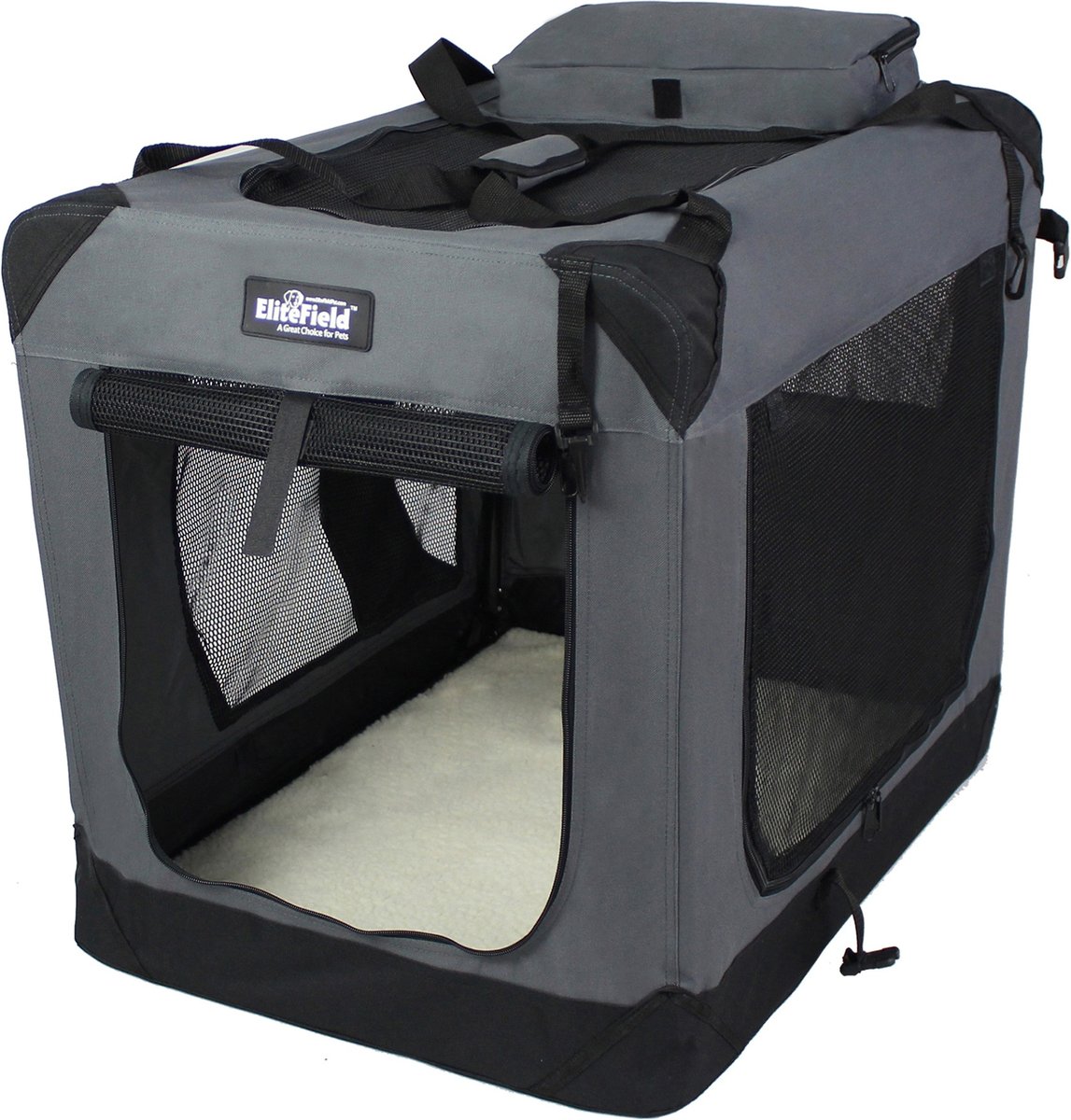Dog Crate: How to Choose and Use the Best
A dog crate offers safety, comfort, and training benefits for your canine companion. Choosing the right size and type is crucial for creating a positive den-like experience. Learn how to properly introduce and use a crate to ensure your dog’s well-being.

It may look like a cage, but in this case, looks are deceiving. Dog crates are a safe, humane, and often soothing training tool that can help reduce anxiety, reinforce routines, and keep your pet safe. When used properly, they offer your pet a comfortable, den-like retreat that satisfies their nesting instincts while giving you some peace of mind in the home or on the road.
We’re here to help you choose the perfect dog crate, nail the training basics, and set your pup up for success in their new hideaway.
- Benefits of a Dog Crate
- How to Choose the Right Dog Crate
- Crate Training Tips
- Best Dog Crates on the Market
- Our Picks
- 1. Best Wire Crate: MidWest LifeStages Collapsible Wire Dog Crate
- 2. Best Plastic Crate: Petmate Two-Door Plastic Crate
- 3. Best Soft-Sided Crate: EliteField Collapsible Soft-Sided Crate
- 4. Best Furniture-Style Crate: Merry Pet 2-in-1 Configurable Pet Crate and Gate
- Final Thoughts

Don’t leave your pet’s safety to chance
Sign up for Petful recall alerts today.

Benefits of a Dog Crate
There is a misconception among some pet lovers that a dog crate is cruel and unpleasant for your dog. In reality, they are an incredibly beneficial and versatile training tool when used properly. Here are a few reasons why:
- Safety: Whether in the home or on the road, dog crates serve as a safety net for many dogs. They help them stay secure during travel, offer a space to seek shelter during stressors like storms or fireworks events, and keep them from getting into dangerous materials when left unsupervised.
- Training: When used as a positive training tool, crates can help support good behavior patterns. They can help with puppy potty training, prevent destructive behaviors, and create reliable daily routines.
- Comfort: Crates that are sized and set up thoughtfully can be a cozy, calming retreat, much like a den.
How to Choose the Right Dog Crate
The type of crate you need will depend on your dog’s size, temperament, training level, and how you intend to use it.
Types of Crates for Dogs
Here are the four main styles of dog crate you’re most likely to see on the market:
- Wire Crates are a convenient option because they are often foldable and easy to move. They’re popular for dogs who are just starting crate training because they offer great visibility and ventilation.
- Plastic Crates: These are generally lightweight and great for traveling, thanks to their durability. That said, they are slightly less breathable than mesh or wire crates.
- Soft-Sided Crates: What they lack in durability, they make up for in portability. These are usually collapsible, easy to pack, and very lightweight. They usually have mesh screens and doors for better ventilation.
- Furniture-Style Crates: These are a great in-home option for dogs who are already crate-trained, as they are more aesthetically pleasing and can blend well with other furniture.
Key Factors to Consider
Here are some of the most important factors to consider when picking out a dog crate:
- Size: This is perhaps the most important detail. Your dog should have enough space to sit, lie down, turn around, and stand without stooping their head. And while you obviously want to give your dog lots of room (because you love them, of course), an oversized crate isn’t ideal either, as it can increase the risk of injuries.
- Material: Do you need a durable crate for everyday use or something lightweight and portable for travel? If your dog is prone to chewing or scratching, for example, some plastic or fabric crates may not be effective.
- Portability: Not all crates break down quickly and easily. If you plan to take your dog on the road or want a crate that you can pop up in the yard or the park, you may want to look for lighter, more portable options.
- Purpose: Consider where and when you will be using the crate. The crate you choose for long-term use in the home may be different from the crate you use to begin training or the one you buy for travel.
Crate Training Tips
Like any behavior tool, the key to using a crate is proper training. Below are some tips to help you get started.
Introduction to Crate Training
The ultimate goal of crate training is to teach your dog that its crate is a safe, comfortable space where they can let their guard down. However, there may be times when you need your dog to stay in its crate for safety and security, and that’s when good training habits really pay off.
When introducing your dog to crate training, start with short stints and gradually increase the time it spends inside. Be sure to praise your dog and offer treats or toys as rewards to make the crate a happy place.
Initially, you should reward your dog for interacting with or entering the crate on their own. Then, you can begin rewarding it for sitting, lying down, or staying in the crate for any length of time.
Making the Crate a Safe and Happy Space
The crate should be a secure place where your dog can relax and unwind. Make it comfortable for resting and sleeping with comfy bedding (make sure this is safe bedding that a major chewer, such as a teething puppy, can’t ingest), favorite toys, and high-value treats. You can even feed your dog meals in the crate to create a sense of safety and build a routine.
Establishing a Routine
Dogs thrive on routine. They are great at recognizing patterns and do best when they can operate on a predictable schedule. Integrate crate training into your daily routine, beginning with short periods inside after playtime or during meals and working up to longer ones when you leave the house or even overnight.
What to Avoid
You want your dog to have positive associations with their crate. To achieve this, avoid using the crate as a tool for punishment—otherwise, it will become a source of stress and anxiety. Never force your dog into the crate before they are ready, and avoid any fear-based training tactics.
It’s also important to be mindful of how long you leave your dog in a crate. If you are leaving the house or keeping them crated overnight, the maximum time for adult dogs who are already crate-trained is eight to nine hours. For pups, one hour in the crate for every month of age is a good rule of thumb.
Best Dog Crates on the Market
By now, it’s probably clear that picking the perfect dog crate is no easy feat. But that’s why you’re here! We’ve narrowed down some of the best dog crates available for you to help keep your dog happy, comfy, and calm.
Our Picks
1. Best Wire Crate: MidWest LifeStages Collapsible Wire Dog Crate

| Material | Coated metal and plastic |
| Sizes Available | XS-XL |
| Portability | High |
| Price Range | $$ |
This is the best wire dog crate for owners looking for a portable, easy-to-use option that will keep their pup secure while offering lots of ventilation and visibility. It folds down flat for easy storage and has a built-in carrying handle.
Highlights
Both doors have locking latches designed to prevent accidental openings from pawing or nudging. The raised plastic base prevents leaks, making it a great option for preventing messes when potty training.
Things to Consider
Because this crate comes with a hard plastic base, you may want to add bedding, padding, or blankets to make it more comfortable.
2. Best Plastic Crate: Petmate Two-Door Plastic Crate

| Material | Plastic and metal |
| Sizes Available | One size for pets up to 15 lbs. |
| Portability | Medium |
| Price Range | $$ |
Small dog crates like this one can be great everyday training tools, but they also make ideal getaway carriers for travel. This crate has front and top entryways, with extra ventilation on the sides for improved airflow. The sturdy plastic is durable and easy to clean, making it the perfect choice for pet parents on the go.
Highlights
The doors have spring-loaded latches for security and easy opening. It’s also airline-approved, but it’s always best to check your specific airline, as specific regulations can vary.
Things to Consider
At just over 24 inches long, this crate is best for small pets. You may want to add padding for extra comfort, especially during travel.
3. Best Soft-Sided Crate: EliteField Collapsible Soft-Sided Crate

| Material | Steel tubing, nylon, polyester, and mesh fabric |
| Sizes Available | XS-L |
| Portability | High |
| Price Range | $$$ |
For convenience and comfort, it doesn’t get much better than this collapsible dog crate. All three doors have locking zippers for extra safety, and with plenty of mesh, your pup can get all the fresh air they need.
Highlights
Setup is quick and easy—no tools required! The crate is not only collapsible, but it includes a carrying case for added convenience. It also comes with a fleece bed, so your dog can relax in style.
Things to Consider
The soft sides and zippers on this crate mean it may not be ideal for puppies or dogs new to crate training, as they can be prone to chewing, gnawing, and pawing.
4. Best Furniture-Style Crate: Merry Pet 2-in-1 Configurable Pet Crate and Gate

| Material | Wood, plastic, and metal |
| Sizes Available | 32.5” and 39.8” |
| Portability | Medium |
| Price Range | $$$ |
For those on the hunt for a fashionable, functional home solution, this wooden furniture-style dog crate is for you! It has a removable plastic tray in the bottom for easy cleaning, and the solid wood veneer top means it doubles as an end table.
Highlights
This convertible crate is more than meets the eye. It’s multi-purpose, giving you the option to open it into a pet fence complete with a gate. That means you can keep your pet safe and limit their access in the home without crating them for long periods.
Things to Consider
Because of the limited sizes, this crate is best for small and medium dogs.
Final Thoughts
Crate training is a great way to ensure your pet is safe, secure, and comfortable—both physically and emotionally. Once you choose the right dog crate, with a little patience, you can teach your dog the joy of their new favorite hangout spot!
Ready to check out more helpful training resources and behavioral tips? Try these pieces to get started:
- 10 Essential Puppy Training Tips
- The Benefits of Training for Older Dogs
- Curing Dog Separation Anxiety Quickly
- 5 Easy Ways to Dog-Proof Your Home
Featured image via Midwest on Chewy







